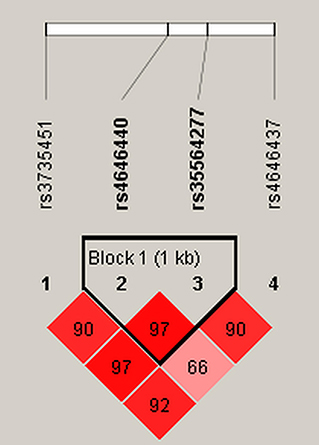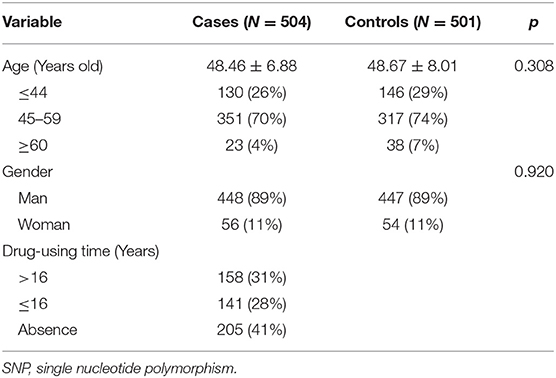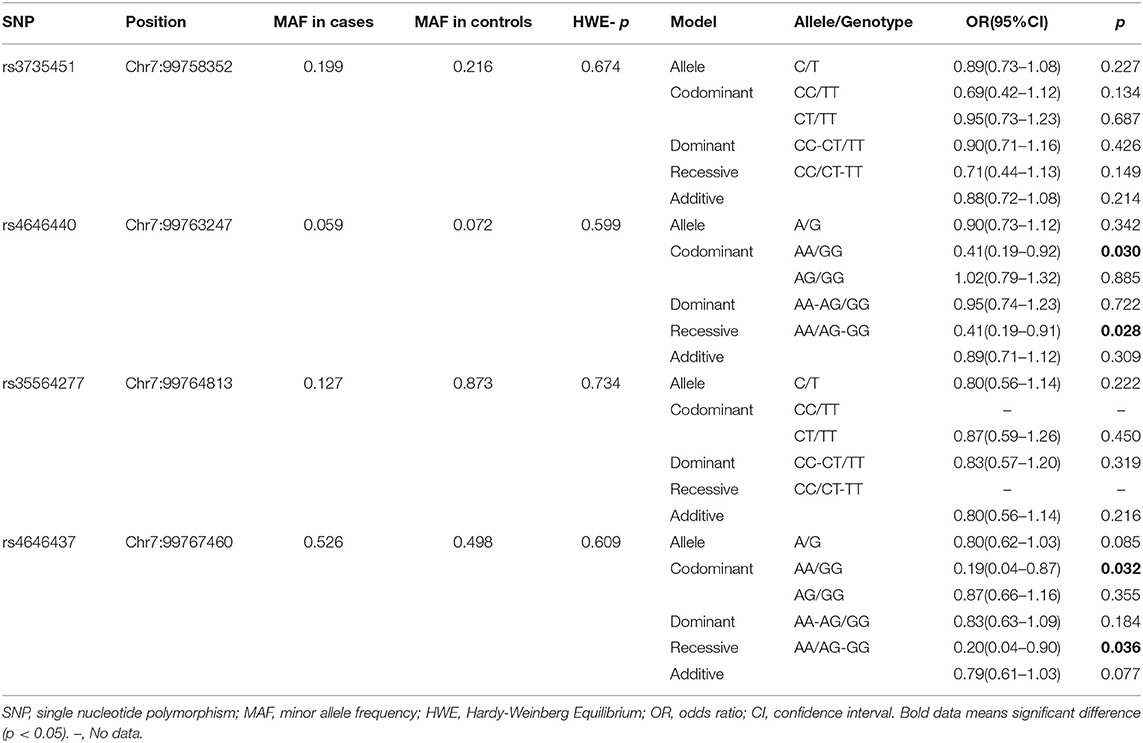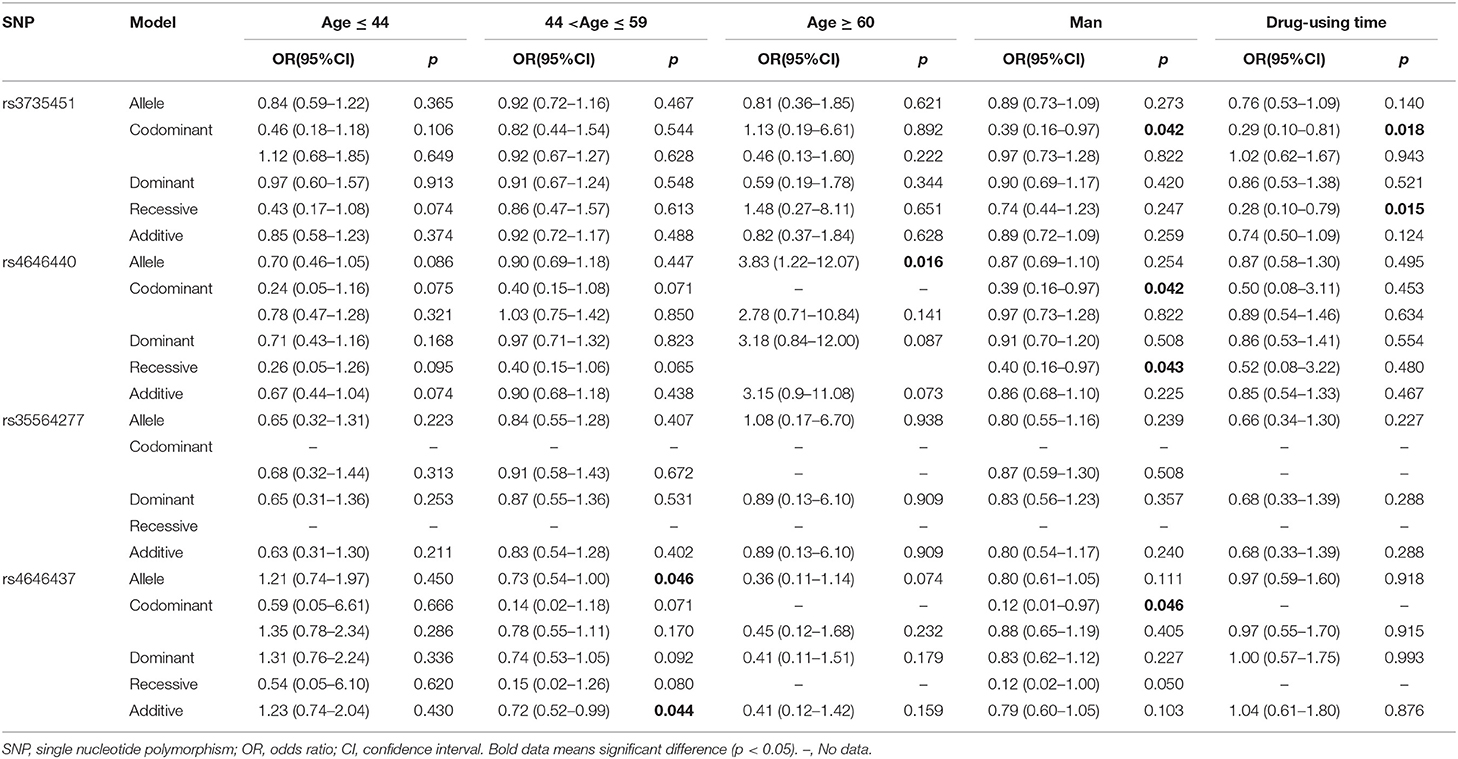- 1Key Laboratory of Molecular Mechanism and Intervention Research for Plateau Diseases of Tibet Autonomous Region, School of Medicine, Xizang Minzu University, Xianyang, China
- 2School of Basic Medical Sciences, Xizang Minzu University, Xianyang, China
- 3Department of Neurology, Affiliated Hospital of Xizang Minzu University, Xianyang, China
- 4Department of Clinical Laboratory, Affiliated Hospital of Xizang Minzu University, Xianyang, China
Background: Cytochrome P450 3A4 (CYP3A4) regulates pharmacokinetic and pharmacodynamic interactions during the process of drug absorption and metabolism, suggesting CYP3A4 plays an important role in drug addiction. However, the association between CYP3A4 polymorphisms and drug addiction risk is still not clear.
Methods: This case-control study included 504 drug addicts and 501 healthy controls from Xi'an, China. Four single nucleotide polymorphisms (SNP) in CYP3A4 (rs3735451, rs4646440, rs35564277, and rs4646437) were genotyped by Agena MassARRAY platform. After adjusting by age and gender, we calculated odd ratios (OR) and 95% confidence intervals (CI) by logistic regression to estimate the association between CYP3A4 polymorphisms and drug addiction risk.
Results: We found rs4646440 and rs4646437 were associated with decreased risk of drug addiction in codominant (rs4646440: OR = 0.41, 95%CI = 0.19–0.92, p = 0.030; rs4646437: OR = 0.19, 95%CI = 0.04–0.87, p = 0.032) and recessive (rs4646440: OR = 0.41, 95%CI = 0.19–0.91, p = 0.028; rs4646437: OR = 0.20, 95%CI = 0.04–0.90, p = 0.036) models. Rs3735451 and rs4646437 were associated with drug addiction risk in the subgroup of middle-aged people (44 < age ≤ 59) and elderly people (age ≥ 60), individually. For men, rs3735451, rs4646440, and rs4646437 had strong relationship with decreased risk of drug addiction (p < 0.05). The effects of rs3735451 on drug addiction risk were related to drug-using time (p < 0.05). We also observed one block (rs4646440 and rs35564277) in haplotype analysis.
Conclusion: CYP3A4 polymorphisms were associated with drug addiction risk among the Chinese Han population.
Introduction
Drug addiction is a chronic relapse disorder characterized by compulsive drug seeking tendencies and usage, paired with substantial morbidity and mortality (1, 2).Worldwide, 99,000–253,000 deaths a year are attributed to drug addiction (3). It is reported that the number of drug users reached nearly 2.96 million until 2014 in China (4). Epidemiological data showed that women had lower rates of drug use than men (5). Drug addiction is influenced by many factors, including environmental, mental, and genetic factors (6, 7). Accumulating studies had proved that gene variety leads to drug addiction accounting for ~50% (6, 8). During the drug addiction, age and sex differences are obvious in clinical and preclinical studies (9). Recently, drug-metabolizing enzyme had been addressed as a major target for drug addiction (10).
Cytochrome P450 (CYP) enzymes are monooxygenases that catalyze many reactions involved in the metabolism of drug, environmental contaminants, steroids and other lipids (11). The CYP3A4 enzyme is the most important drug-metabolizing P450s in the liver, which encoded by CYP3A4 gene (12). CYP3A4 enzyme is mainly responsible for methadone metabolism and hence uses for the treatment of drug addiction (13). CYP3A4 polymorphisms were also significantly associated with sedation side effects caused by methadone and several clinical conditions (ischemic stroke and epilepsy) (14–16). Previous study showed CYP3A4 rs2242480 was significantly associated with drug addiction in Xi'an Han Chinese population (17), and CYP3A4*4 allele was related to an increase in the lipid-lowering effects of simvastatin by decreasing CYP3A4 activity (18). In the CYP3A4 gene, rs4646440, and rs4646437 were the most common polymorphisms. Studies revealed that rs4646440 had strong relationship with withdrawal symptoms and adverse reactions in methadone maintenance patients (14). Rs4646437 had effects on the risk of many diseases, such as hypertension, human immunodeficiency virus (HIV) and some cancers (19–21). However, the study of association between CYP3A4 polymorphisms and drug addiction risk among the Chinese Han population is scarcely.
To assess the effects of CYP3A4 polymorphisms on drug addiction risk, we conducted a case-control study to explore the association of CYP3A4 polymorphisms (rs3735451, rs4646440, rs35564277, and rs4646437) and drug addiction risk among the Chinese Han population.
Methods
Study Participants
Between 2016 and 2018, 504 drug addicts were recruited from Xi'an addiction treatment center and 501 healthy controls were randomly selected from Xi'an medical examination center. All cases had daily uses of narcotics (including hemp, opium, and cocaine) for 1 or more years and had a clinical characteristics of drug addiction, which confirmed by urine tests. The patients with seizure disorder, psychotic or severe medical illness were excluded. The control subjects were healthy individuals assessed by the Addiction Severity Index (22, 23) and people had endocrine, metabolic, nutritional or severe diseases were excluded. All participants were over the age of 18 and signed informed consents before study. We obtained written informed consents from all participants. Our study was approved by the ethic committee of Clinical Research Ethics of Northwest University.
Genotyping
Combined previous studies, four polymorphisms (rs3735451, rs4646440, rs35564277, and rs4646437) with minor allele frequencies >5% in the Chinese Han Beijing population were selected. Genomic DNA was extracted from whole blood samples by GoldMag–Mini Purification Kit (GoldMag Co. Ltd. Xi'an, China) and was quantified by DU530 UV/VIS spectrophotometer (Beckman Instruments, Fullerton, CA, USA). Agena MassARRAY Assay Design 3.0 software was used to design primers in this study (Table 1). Genotyping was performed by the standard protocol from the Agena MassARRAY RS1000 manufacturer, data were managed and analyzed using the Agena Typer 4.0 Software (24).
Statistical Analysis
We used Microsoft Excel and SPSS 18.0 (SPSS, Chicago, IL) to conduct statistical analysis. All p-values were two-sided and p < 0.05 was regard as statistical significance. The Hardy-Weinberg equilibrium (HWE) for each single nucleotide polymorphism (SNP) in controls was evaluated by Chi-square test. The categorical and continuous variables were assessed using Chi-square test and t-test, individually. After adjusted by age and gender, the association of CYP3A4 polymorphisms and drug addiction risk was estimated using logistic regression analysis by calculating odd ratio (OR) and 95% confidence intervals (CI). Genetic models (codominant, dominant, recessive, and additive) was performed on PLINK software. Linkage disequilibrium (LD) and haplotype construction were conducted by Haploview software (version 4.2) (25).
Results
The characteristics of participants were presented in Table 2. Our study included 504 cases (448 men, 56 women) and 501 controls (447 men, 54 women). The mean ages of cases and controls were 48.46 ± 6.88 and 48.67 ± 8.01, respectively. There were no significant differences in age and gender between two groups (age: p = 0.308, gender: p = 0.920). For all cases, 158 (31%) had drug addiction more than 16 years, 144 (28%) had drug addiction equal or <16 years, the other people (205, 41%) did not have the information of drug-using time
As shown in Table 3, the MAFs of four SNPs in two groups were listed, and all SNPs were in HWE (p > 0.05). The association between CYP3A4 polymorphisms and drug addiction risk in allele model was also shown in Table 3. Compared with GG genotype, the individuals with rs4646440 AA genotype had significantly decreased risk of drug addiction (OR = 0.41, 95%CI = 0.19–0.92, p = 0.030). In recessive model, rs4646440 had strong relationship with drug addiction risk (OR = 0.41, 95%CI = 0.19–0.91, p = 0.028). Additionally, rs4646437 was significantly associated with drug addiction risk in codominant (OR = 0.19, 95%CI = 0.04–0.87, p = 0.032) and recessive (OR = 0.20, 95%CI = 0.04–0.90, p = 0.036) models.
Furthermore, we performed stratified analysis of association between CYP3A4 polymorphisms and drug addiction risk (Table 4). Rs4646437 had a strong relationship with drug addiction among middle-aged people (44 <Age ≤ 59) in allele (OR = 0.73, 95%CI = 0.54–1.00, p = 0.046) and additive (OR = 0.72, 95%CI = 0.52–0.99, p = 0.044) models. For the individuals equal or more than 60 years old, rs4646440 was related to increased drug addiction risk in allele model (OR = 3.83, 95%CI = 1.22–12.07, p = 0.016). In the subgroup of man, rs3735451, rs4646440, and rs4646437 were related to decreased drug addiction risk in codominant (rs3735451: OR = 0.39, 95%CI = 0.16–0.97, p = 0.042; rs4646440: OR = 0.39, 95%CI = 0.16–0.97, p = 0.042; rs4646437: OR = 0.12, 95%CI = 0.01–0.97, p = 0.046) and recessive (rs4646440: OR = 0.40, 95%CI = 0.16–0.97, p = 0.043) models. Moreover, the effects of rs3735451 on drug addiction were related to drug-using time (codominant: OR = 0.29, 95%CI = 0.10–0.81, p = 0.018; recessive: OR = 0.28, 95%CI = 0.10–0.79, p = 0.015).
And, we did haplotype analysis of association between CYP3A4 polymorphisms and drug addiction risk (Table 5). We did not observe significant relationships between CYP3A4 haplotype and drug addiction risk (p > 0.05). In Figure 1, we detected one block (rs4646440 and rs35564277).

Figure 1. Haplotype block map for CYP3A4 polymorphisms. Block 1 includes rs4646440 and rs35564277. The numbers inside the diamonds indicate the D′ for pairwise analyses.
Discussion
In this study, we firstly found that CYP3A4 polymorphisms (rs3735451, rs4646440, rs35564277, and rs4646437) were associated with drug addiction risk among the Chinese Han population. Especially, rs4646440 and rs4646437 were significantly associated with decreased risk of drug addiction. Stratified analysis showed that the effects of rs4646440 and rs4646437 on drug addiction risk are dependent on age and gender. Drug-using time also related to the association of rs3735451 and drug addiction risk. In addition, we observed one block (rs4646440 and rs35564277) by haplotype analysis.
CYP3A4 is the major congener of CYP family, which is highly expressed in intestine and liver. In vitro, experiment showed morphine enhances CYP3A4 expression (26). CYP3A4 controls the metabolism of more than 70% of all drugs in human, including cocaine and opiate (27, 28). However, inter-individual variation in drug response is obvious. Growing evidence indicates that inter-individual variability in drug response is related to genetic polymorphisms. CYP3A isoenzymes are related to patients with alcohol use disorder by regulating haloperidol concentration (29).The effects of CYP3A4 rs4646437 on drug is the most studied. He et al. found rs4646437 related to voriconazole metabolism, suggesting the impact of CYP3A4 on the pharmacokinetics of antifungal agent (30). Among Chinese renal transplant recipients, rs4646437 could affect the interindividual variability in the metabolism of tacrolimus (31). In addition, rs4646437 was significantly associated with prostate cancer by modifying finasteride concentration (32). In this study, we observed rs4646440 and rs4646437 of CYP3A4 had strong relationships with drug addiction risk. It suggests the role of CYP3A4 polymorphisms in drug addiction. Further functional studies are needed to verify the effects of CYP3A4 polymorphisms on drug addiction.
Although drug addiction generally occurs in the young, increasing prevalence drug use by elderly people is not ignorable (33). It was reported that drug addiction accelerated aging process in aging drug users (33). According to age classification criteria of the World Health Organization (WHO), we divided individuals into three groups (youth, middle-aged people and elderly people). In the subgroup of age ≥ 60, rs4646440 significantly increased risk of drug addiction. Rs4646437 was associated with drug addiction for the middle-aged people (44 <Age ≤ 59). Additionally, sex differences in drug abuse are common in drug addiction. For instance, men are more likely to use heroin than women and men take greater amounts of heroin (34, 35), it may be attributed to the molecular neuroadaptations. For participants in this study, there are more men than women. We hence performed association analysis in man and found CYP3A4 polymorphisms (rs3735451, rs4646440, and rs4646437) decreased drug addiction risk. Finally, we explored the association of CYP3A4 polymorphisms and drug addiction risk in individuals had different drug-using time. We observed that the influence of rs3735451 on drug addiction risk was related to drug-using time. Our results indicated that age, gender and drug-using time affect the relationship between CYP3A4 polymorphisms and drug addiction risk. The exact mechanisms are required to study in the future.
Some limitations could not be ignored in this study. First, study participants are limited to the Chinese Han population. Second, drug addiction is caused by multiple factors, we could not eliminate the effects of all potential factors on drug addiction risk. Third, we could not do more stratified analyses due to limited information of participants or characteristic discrepancy. Hence, more ethnic population and well-designed studies are required to verify the association of CYP3A4 polymorphisms and drug addiction risk.
Conclusion
In summary, our study suggests that CYP3A4 polymorphisms could be associated with drug addiction risk among the Chinese Han population and the associations are related to age, gender and drug-using time. Further studies in larger population with more experiments are required to confirm our results.
Data Availability Statement
The raw data supporting the conclusions of this manuscript will be made available by the authors, without undue reservation, to any qualified researcher.
Author Contributions
LW, MB, TJ, and JZ performed this study. YW, YH, and DY collected samples. XH supervised this study.
Funding
This work was supported by Major Science and Technology Research Projects of Xizang (Tibet) Autonomous Region (2015XZ01G23).
Conflict of Interest
The authors declare that the research was conducted in the absence of any commercial or financial relationships that could be construed as a potential conflict of interest.
Acknowledgments
We thank the participants involved in our study. We also thank our study team, without whose collaboration, this article would not have been written.
References
1. Nestler EJ. Molecular basis of long-term plasticity underlying addiction. Nat Rev Neurosci. (2001) 2:119–28. doi: 10.1038/35053570
2. Wakefield JC. DSM-5 substance use disorder: how conceptual missteps weakened the foundations of the addictive disorders field. Acta Psychiatr Scand. (2015) 132:327–34. doi: 10.1111/acps.12446
3. Burns L. World drug report 2013 by United Nations Office on drugs and crime New York: United Nations, 2013ISBN: 978-92-1-056168-6, 151 pp. Grey literature. Drug Alcohol Rev. (2014) 33:216. doi: 10.1111/dar.12110
4. Marienfeld C. Heroin addiction, methadone, and HIV in China. Lancet Psychiatry. (2016) 3:799–800. doi: 10.1016/S2215-0366(16)30130-4
5. Bobzean SA, DeNobrega AK, Perrotti LI. Sex differences in the neurobiology of drug addiction. Exp Neurol. (2014) 259:64–74. doi: 10.1016/j.expneurol.2014.01.022
6. Zhang C, Ding H, Cheng Y, Chen W, Li Q, Li Q, et al. Genetic polymorphisms in ALDH2 are associated with drug addiction in a Chinese Han population. Oncotarget. (2017) 8:8597–603. doi: 10.18632/oncotarget.14354
7. Johnson JL, Leff M. Children of substance abusers: overview of research findings. Pediatrics. (1999) 103(Suppl. 2):1085–99.
8. Kendler KS, Jacobson KC, Prescott CA, Neale MC. Specificity of genetic and environmental risk factors for use and abuse/dependence of cannabis, cocaine, hallucinogens, sedatives, stimulants, and opiates in male twins. Am J Psychiatry. (2003) 160:687–95. doi: 10.1176/appi.ajp.160.4.687
9. Zhou Y, Zhao M, Zhou C, Li R. Sex differences in drug addiction and response to exercise intervention: from human to animal studies. Front Neuroendocrinol. (2016) 40:24–41. doi: 10.1016/j.yfrne.2015.07.001
10. Zhang D, Shao C, Shao M, Yan P, Wang Y, Liu Y, et al. Effect of μ-opioid receptor gene polymorphisms on heroin-induced subjective responses in a Chinese population. Biol Psychiatry. (2007) 61:1244–51. doi: 10.1016/j.biopsych.2006.07.012
11. Depaz IMB, Toselli F, Wilce PA, Gillam EM. Differential expression of human cytochrome P450 enzymes from the CYP3A subfamily in the brains of alcoholic subjects and drug-free controls. Drug Metabol Dispos. (2013) 41:1187–94. doi: 10.1124/dmd.113.051359
12. Krishna D, Shekar M. Cytochrome P450 3A: genetic polymorphisms and interethnic differences. Methods Find Exp Clin Pharmacol. (2005) 27:559–68. doi: 10.1358/mf.2005.27.8.928310
13. Chang Y, Fang WB, Lin SN, Moody DE. Stereo-selective metabolism of methadone by human liver microsomes and cDNA-expressed cytochrome P450s: a reconciliation. Basic Clin Pharmacol Toxicol. (2011) 108:55–62. doi: 10.1111/j.1742-7843.2010.00628.x
14. Chen C-H, Wang S-C, Tsou H-H, Ho I-K, Tian J-N, Yu C-J, et al. Genetic polymorphisms in CYP3A4 are associated with withdrawal symptoms and adverse reactions in methadone maintenance patients. Pharmacogenomics. (2011) 12:1397–406. doi: 10.2217/pgs.11.103
15. Li S, Shi C-h, Liu X-j, Li Y-s, Li S-h, Song B, et al. Association of CYP3A4* 1G and CYP3A5* 3 with the 1-year outcome of acute ischemic stroke in the Han Chinese population. J Stroke Cerebrovasc Dis. (2019) 28:1860–5. doi: 10.1016/j.jstrokecerebrovasdis.2019.04.013
16. Caruso A, Bellia C, Pivetti A, Agnello L, Bazza F, Scazzone C, et al. Effects of EPHX1 and CYP3A4 polymorphisms on carbamazepine metabolism in epileptic patients. Pharmacogenom Personalized Med. (2014) 7:117–20. doi: 10.2147/PGPM.S55548
17. Zhang H, Yang Q, Zheng W, Ouyang Y, Yang M, Wang F, et al. CYP gene family variants as a potential risk factors in drug addiction in Han Chinese. J Gene Med. (2016) 18:147–53. doi: 10.1002/jgm.2887
18. An W, Yu BN, Luo CH, Tan ZR, Gan Z, Wang LS, et al. Ile118Val genetic polymorphism of CYP3A4 and its effects on lipid-lowering efficacy of simvastatin in Chinese hyperlipidemic patients. Euro J Clin Pharmacol. (2005) 60:843–8. doi: 10.1007/s00228-004-0848-7
19. Diekstra M, Belaustegui A, Swen J, Boven E, Castellano D, Gelderblom H, et al. Sunitinib-induced hypertension in CYP3A4 rs4646437 A-allele carriers with metastatic renal cell carcinoma. Pharmacogenom J. (2017) 17:42–6. doi: 10.1038/tpj.2015.100
20. Wang J, Ji H, Jia H, Guan D. Association between CYP3A4 gene rs4646437 polymorphism and the risk of hypertension in Chinese population: a case-control study. Biosci Rep. (2019) 39:BSR20190296. doi: 10.1042/BSR20190296
21. de Almeida TB, de Azevedo MCVM, Pinto JFdC, Ferry FRdA, da Silva GAR, de Castro IJ, et al. Drug metabolism and transport gene polymorphisms and efavirenz adverse effects in Brazilian HIV-positive individuals. J Antimicrob Chemother. (2018) 73:2460–7. doi: 10.1093/jac/dky190
22. Denis C, Fatséas M, Beltran V, Serre F, Alexandre J-M, Debrabant R, et al. Usefulness and validity of the modified addiction severity index: a focus on alcohol, drugs, tobacco, and gambling. Subst Abuse. (2016) 37:168–75. doi: 10.1080/08897077.2015.1036334
23. Cacciola JS, Alterman AI, Habing B, McLellan AT. Recent status scores for version 6 of the Addiction Severity Index (ASI-6). Addiction. (2011) 106:1588–602. doi: 10.1111/j.1360-0443.2011.03482.x
24. Jin T, Zhang P, Shi X, Ouyang Y, He N, He X, et al. Genetic analysis of drug-metabolizing enzyme CYP3A5 polymorphisms in Tibetans in China. Int J Clin Exp Pathol. (2016) 9:3717–25.
25. Ding Y, Xu D, Zhang X, Yang H, Geng T, He P, et al. Genetic polymorphisms and phenotypic analysis of drug-metabolizing enzyme CYP2C19 in a Li Chinese population. Int J Clin Exp Pathol. (2015) 8:13201.
26. Pal D, Kwatra D, Minocha M, Paturi DK, Budda B, Mitra AK. Efflux transporters-and cytochrome P-450-mediated interactions between drugs of abuse and antiretrovirals. Life Sci. (2011) 88:959–71. doi: 10.1016/j.lfs.2010.09.012
27. Krishna DR, Klotz U. Extrahepatic metabolism of drugs in humans. Clin Pharmacokinet. (1994) 26:144–60. doi: 10.2165/00003088-199426020-00007
28. Watkins PB. The barrier function of CYP3A4 and P-glycoprotein in the small bowel. Adv Drug Deliv Rev. (1997) 27:161–70. doi: 10.1016/S0169-409X(97)00041-0
29. Sychev DA, Zastrozhin MS, Miroshnichenko II, Baymeeva NV, Smirnov VV, Grishina EA, et al. Genotyping and phenotyping of CYP2D6 and CYP3A isoenzymes in patients with alcohol use disorder: correlation with haloperidol plasma concentration. Drug Metab Personalized Ther. (2017) 32:129–36. doi: 10.1515/dmpt-2017-0021
30. He H-R, Sun J-Y, Ren X-D, Wang T-T, Zhai Y-J, Chen S-Y, et al. Effects of CYP3A4 polymorphisms on the plasma concentration of voriconazole. Euro J Clin Microbiol Infect Dis. (2015) 34:811–9. doi: 10.1007/s10096-014-2294-5
31. Li C-J, Li L, Lin L, Jiang H-X, Zhong Z-Y, Li W-M, et al. Impact of the CYP3A5, CYP3A4, COMT, IL-10 and POR genetic polymorphisms on tacrolimus metabolism in Chinese renal transplant recipients. PLoS ONE. (2014) 9:e86206. doi: 10.1371/journal.pone.0086206
32. Chau CH, Price DK, Till C, Goodman PJ, Chen X, Leach RJ, et al. Finasteride concentrations and prostate cancer risk: results from the Prostate Cancer Prevention Trial. PLoS ONE. (2015) 10:e0126672. doi: 10.1371/journal.pone.0126672
33. Carew AM, Comiskey C. Treatment for opioid use and outcomes in older adults: a systematic literature review. Drug Alcohol Depend. (2018) 182:48–57. doi: 10.1016/j.drugalcdep.2017.10.007
34. Statistics CfBH Quality. Key Substance Use and Mental Health Indicators in the United States: Results from the 2015 National Survey on Drug Use and Health. (HHS Publication No SMA 16-4984, NSDUH Series H-51) (2016).
Keywords: CYP3A4, drug addiction, case-control study, polymorphisms, Chinese Han population
Citation: Wang L, Bai M, Jin T, Zheng J, Wang Y, He Y, Yuan D and He X (2019) Effects of CYP3A4 Polymorphisms on Drug Addiction Risk Among the Chinese Han Population. Front. Public Health 7:315. doi: 10.3389/fpubh.2019.00315
Received: 13 August 2019; Accepted: 14 October 2019;
Published: 19 November 2019.
Edited by:
Jimmy Thomas Efird, University of Newcastle, AustraliaReviewed by:
Charalampos Socrates Siristatidis, National and Kapodistrian University of Athens, GreeceMarcello Ciaccio, University of Palermo, Italy
Luisa Agnello, University of Palermo, Italy
Copyright © 2019 Wang, Bai, Jin, Zheng, Wang, He, Yuan and He. This is an open-access article distributed under the terms of the Creative Commons Attribution License (CC BY). The use, distribution or reproduction in other forums is permitted, provided the original author(s) and the copyright owner(s) are credited and that the original publication in this journal is cited, in accordance with accepted academic practice. No use, distribution or reproduction is permitted which does not comply with these terms.
*Correspondence: Xue He, aGV4dWUmI3gwMDA0MDt4em11LmVkdS5jb20=
 Li Wang1,2
Li Wang1,2 Xue He
Xue He



